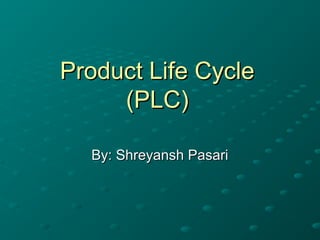
Product life cycle shreyansh 4 l
- 1. Product Life CycleProduct Life Cycle (PLC)(PLC) By: Shreyansh PasariBy: Shreyansh Pasari
- 2. TopicsTopics The Four Major Stages:The Four Major Stages: Market IntroductionMarket Introduction Market GrowthMarket Growth Market MaturityMarket Maturity Sales DeclineSales Decline GraphGraph ExampleExample Pros and ConsPros and Cons
- 3. Stage 1: Market IntroductionStage 1: Market Introduction Sales are low as the new idea is first introducedSales are low as the new idea is first introduced to the market.to the market. Customers may not be aware of the productCustomers may not be aware of the product’s’s benefits and features and may not be aware ofbenefits and features and may not be aware of the product itself.the product itself. Most companies experience losses during theMost companies experience losses during the market introduction stage.market introduction stage. A lot of money is spent on promotion and productA lot of money is spent on promotion and product development to build product awareness.development to build product awareness. Promotion is aimed at innovators and early adopters.Promotion is aimed at innovators and early adopters. Pricing:Pricing: Low penetration pricingLow penetration pricing High skim pricingHigh skim pricing
- 4. Stage 2: Market GrowthStage 2: Market Growth Rapid growth in sales and profitsRapid growth in sales and profits More product awarenessMore product awareness Competitors see the opportunity and enterCompetitors see the opportunity and enter the market.the market. Some competitors will copy the product orSome competitors will copy the product or may try to make it better or more appealing tomay try to make it better or more appealing to other target markets.other target markets. The new entries result in more productThe new entries result in more product variety.variety.
- 5. Additional features and support servicesAdditional features and support services may be added to:may be added to: Combat competitionCombat competition Retain customersRetain customers Promotion is aimed at a broader audience.Promotion is aimed at a broader audience. More distribution channels areMore distribution channels are established.established.
- 6. Stage 3: Market MaturityStage 3: Market Maturity Most common stage in the cycle.Most common stage in the cycle. Sales begin to level off.Sales begin to level off. The competition gets tougher as moreThe competition gets tougher as more competitors have entered the market.competitors have entered the market. Increased competition creates a downwardIncreased competition creates a downward movement in prices.movement in prices. Industry profits are largest, but it is alsoIndustry profits are largest, but it is also when industry profits begin to decline.when industry profits begin to decline. Promotion is targeted to create brandPromotion is targeted to create brand differentiation.differentiation.
- 7. Stage 4: Sales DeclineStage 4: Sales Decline Sales continue to decline.Sales continue to decline. Shrinking marketShrinking market New products replace the old.New products replace the old. Firms will often try to use extensionFirms will often try to use extension strategies.strategies. Companies may be able to keep someCompanies may be able to keep some sales by appealing to their most loyalsales by appealing to their most loyal customers.customers.
- 8. When in the decline stage, a firm may:When in the decline stage, a firm may: MaintainMaintain: enhance the product by finding new: enhance the product by finding new uses or by adding new features.uses or by adding new features. HarvestHarvest: reduce costs and continue to offer: reduce costs and continue to offer the product to a targeted niche.the product to a targeted niche. DiscontinueDiscontinue: sell the product to another firm,: sell the product to another firm, or liquidate inventory.or liquidate inventory.
- 10. Example: New Flavor of PepsiExample: New Flavor of Pepsi Stage 1: Market IntroductionStage 1: Market Introduction Pepsi bottles the new flavored product andPepsi bottles the new flavored product and places it on the market for consumers.places it on the market for consumers. Pepsi also spends a lot of money advertisingPepsi also spends a lot of money advertising the new flavor creating awareness.the new flavor creating awareness. Stage 2: Market GrowthStage 2: Market Growth Customers like the flavor and begin to makeCustomers like the flavor and begin to make routine purchases.routine purchases. Coke introduces their competing flavor.Coke introduces their competing flavor.
- 11. Stage 3: Market MaturityStage 3: Market Maturity More competitors enter the market takingMore competitors enter the market taking some of Pepsisome of Pepsi’s profits.’s profits. Stage 4: Sales DeclineStage 4: Sales Decline Customers have moved on to the next newCustomers have moved on to the next new flavor.flavor. Some loyal fans stay behind.Some loyal fans stay behind.
- 12. ProsPros The product life cycle is a useful model whenThe product life cycle is a useful model when deciding possible stages of a product ordeciding possible stages of a product or service.service. Useful to help demonstrate how marketingUseful to help demonstrate how marketing strategies can vary at different stages of astrategies can vary at different stages of a product's life.product's life. PromotionPromotion Pricing StrategiesPricing Strategies
- 13. ConsCons Tends to be backward lookingTends to be backward looking We only know which stage we have been inWe only know which stage we have been in after it has been completed.after it has been completed. Only looks at a single product when mostOnly looks at a single product when most firms have many products.firms have many products. DeterminismDeterminism
- 14. Thank You.
